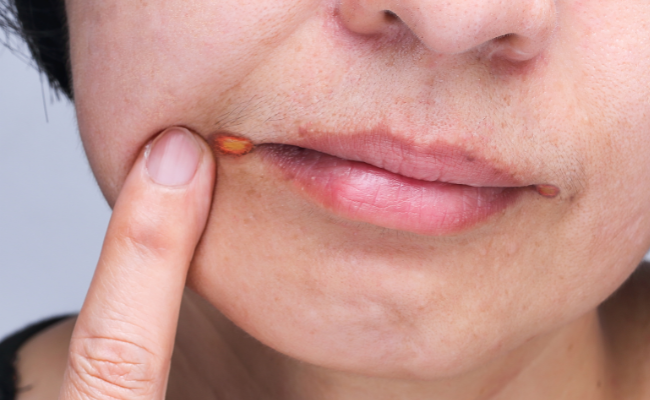How to Treat Angular Cheilitis?
- September 29, 2023
- No Comments

What is Angular Cheilitis?
Angular cheilitis, also recognized as perleche or angular stomatitis, is a widespread condition marked by inflammation and fissures at the corners of the mouth. It can be uneasy, at times painful, leading to redness, swelling, and skin cracking in the affected area. Grasping the causes, symptoms, and effective treatment choices is vital for the management and alleviation of angular cheilitis. This skin condition affecting the mouth's corners results in painful and fissured sores, often confused with cold sores.
Unlike cold sores, angular cheilitis is non-contagious. Treatment typically involves the use of specialized skin ointments, prescribed medications, or dietary adjustments. With proper care, this condition typically resolves, bringing relief from its discomforting symptoms.
Why Does Angular Cheilitis Occur?
Several factors can contribute to the development of angular cheilitis:
- Microbial Infections: Fungal, bacterial, or yeast infections, often due to the presence of Candida, can be a primary cause.
- Nutritional Deficiencies: Lack of essential nutrients like vitamin B, iron, or zinc may make the skin more susceptible to infections.
- Excessive Moisture: Prolonged exposure to moisture, such as drooling in infants or constant lip licking, can create a favorable environment for fungal or bacterial growth.
- Compromised Immune System: Conditions that weaken the immune system, such as HIV/AIDS or autoimmune disorders, may increase the risk.
How Does Angular Cheilitis Manifest?
Angular cheilitis presents with distinct signs and symptoms:
- Pain and Discomfort: The corners of the mouth may become sore, and movements like talking or eating can cause pain.
- Redness and Swelling: Inflammation in the affected area leads to visible redness and swelling.
- Cracking and Fissures: The skin at the corners of the mouth may crack, leading to open sores or fissures.
- Dryness and Itching: The affected skin may feel dry and itchy, adding to the discomfort.
Treatment Solutions for Angular Cheilitis:
- Topical Antifungal or Antibacterial Creams: Applying over-the-counter antifungal or antibacterial creams can help eliminate microbial infections. Prescription-strength options may be recommended for severe cases.
- Topical Steroids: In cases with significant inflammation, topical steroids can reduce swelling and provide relief. However, their use should be supervised by a healthcare professional due to potential side effects.
- Topical Moisturizers: Regular application of lip balms or emollients can prevent excessive dryness and help the healing process.
- Oral Antifungal Medications: For cases with fungal involvement, oral antifungal medications may be prescribed by a healthcare professional.
- Nutritional Supplements: Addressing nutritional deficiencies with supplements, particularly vitamin B, iron, and zinc, can aid in healing and prevent recurrence.
- Addressing Underlying Causes: Identifying and addressing underlying factors, such as correcting malocclusion, managing diabetes, or treating immune system disorders, is crucial for preventing recurrent episodes.
Benefit Points of Angular Cheilitis Treatment:
- Pain Relief: Effective treatment provides relief from pain and discomfort associated with angular cheilitis, allowing for normal daily activities without hindrance.
- Faster Healing: Proper care and treatment facilitate a quicker healing process, reducing the duration of symptoms.
- Prevention of Complications: Timely treatment helps prevent complications such as secondary bacterial infections or scarring.
- Improved Aesthetic Appearance: Treating angular cheilitis helps restore a natural and healthy appearance to the corners of the mouth.
- Enhanced Quality of Life: Alleviating the symptoms of angular cheilitis contributes to an improved overall quality of life, reducing physical and emotional distress.
- Prevent Recurrence: Identifying and addressing underlying causes and risk factors can help prevent the recurrence of angular cheilitis.
Comments (0)